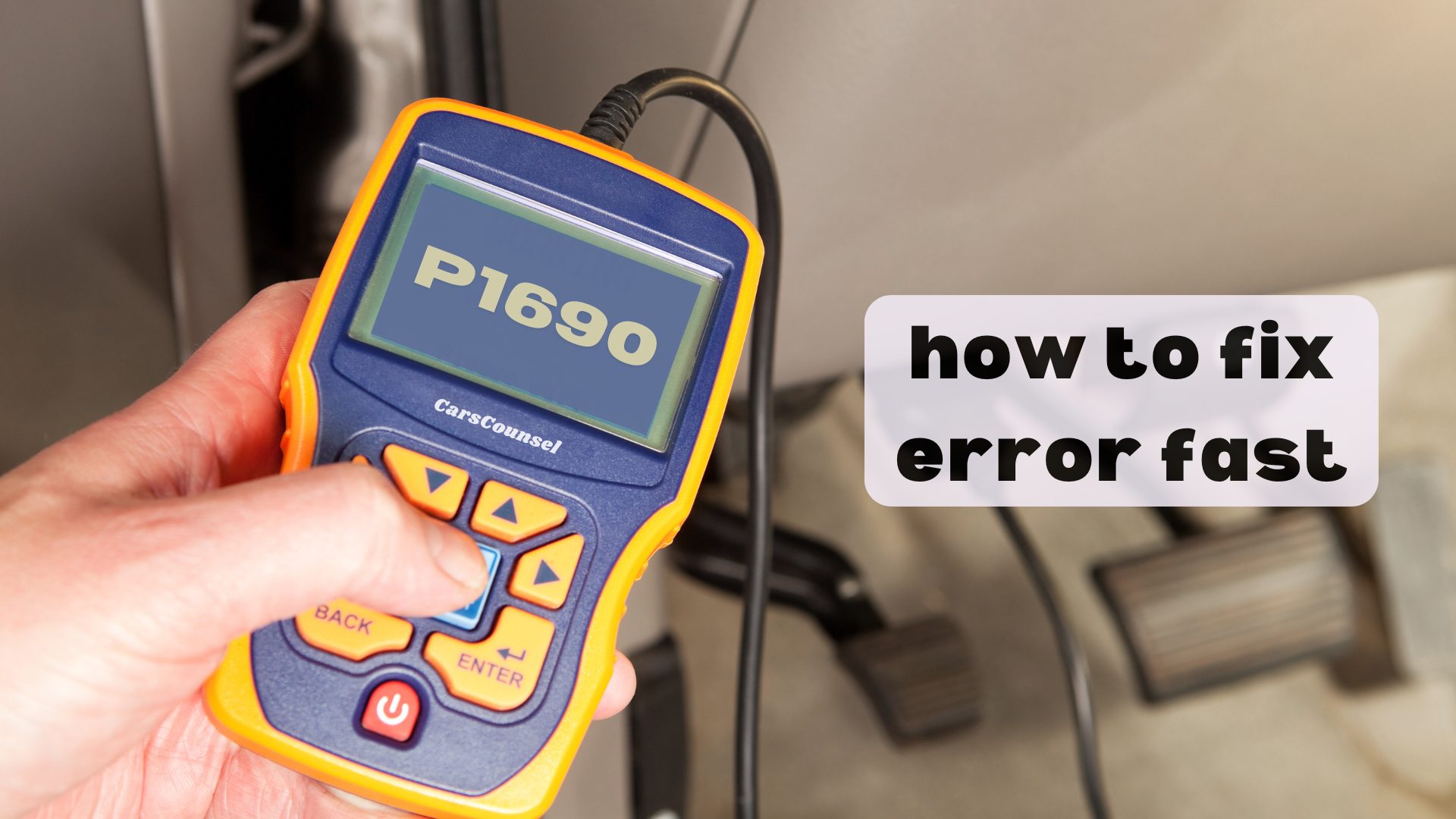You might think a faulty sensor is no big deal, but in regards to the Fuel Injection Pump Crankshaft Position (CKP) sensor and the Engine Control Module (ECM) CKP sensor disagreeing, it’s a whole different story. This discrepancy, indicated by the P1690 code, can wreak havoc on your engine’s performance, causing rough idling, poor acceleration, and even stalling.
But what’s really going on behind the scenes? Is it a wiring issue, a faulty sensor, or something more complex? As you investigate the possible causes and symptoms, you’ll realize that getting to the bottom of this fault code is vital to preventing further damage and ensuring your engine runs smoothly.

Quick Navigation
Key Takeaways
- The P1690 code indicates a disagreement between the Fuel Injection Pump CKP sensor and the Engine Control Module (ECM) CKP sensor, affecting fuel system performance.
- Ignoring this code can result in rough idling, poor acceleration, misfires, and stalling, ultimately causing engine damage over time.
- The CKP sensor plays a vital role in monitoring crankshaft position and speed, essential for proper fuel injection and engine performance optimization.
- Faulty CKP sensors, wiring or connection issues, ECM malfunctions, incorrect sensor installation, and mechanical crankshaft issues can cause the P1690 code.
- A methodical approach is necessary to identify the root cause of the P1690 issue, involving sensor diagnostics, testing, and inspecting the crankshaft and wiring connections.
Understanding Code P1690
When your vehicle’s onboard computer throws a P1690 code, it’s indicating a disagreement between the Fuel Injection Pump Crankshaft Position (CKP) sensor and the Engine Control Module (ECM) CKP sensor.
This discrepancy affects your fuel system overview, as the CKP sensor plays a vital role in monitoring crankshaft position and speed, which is essential for proper fuel injection and engine performance optimization.
A mismatch between the sensors can lead to issues with fuel delivery, ignition timing, and overall engine performance. Ignoring this code can result in rough idling, poor acceleration, misfires, and stalling, ultimately causing engine damage over time.
It’s essential to address this issue promptly to prevent further complications.
CKP Sensor Function and Importance
Most modern engines rely on a CKP sensor to accurately monitor the position and speed of the crankshaft, providing vital data to the Engine Control Module (ECM) for fuel injection and ignition timing.
You might be wondering how this sensor came to be so pivotal. The CKP sensor has a rich history, dating back to the early days of fuel injection systems.
Its development marked a significant milestone in engine performance, as it enabled more precise control over fuel delivery and ignition. Today, the CKP sensor is an essential component, ensuring your engine runs smoothly and efficiently.
Its importance can’t be overstated, as any malfunction can lead to poor engine performance, decreased fuel efficiency, and even engine damage.
Causes of the P1690 Code
What triggers the P1690 code, and why does it occur in the first place? The code is triggered when there’s a discrepancy between the Fuel Injection Pump Crankshaft Position (CKP) sensor and the Engine Control Module (ECM) CKP sensor. This can happen due to various reasons, including faulty CKP sensors, wiring or connection issues, ECM malfunctions, incorrect sensor installation, or mechanical issues with the crankshaft.
| Cause | Effect | Solution |
|---|---|---|
| Faulty CKP sensor | Incorrect crankshaft position data | Replace faulty sensor |
| Wiring or connection issues | Disrupted sensor signal | Repair or replace damaged wiring |
| ECM malfunction | Incorrect sensor data processing | Reset or replace ECM if necessary |
| Incorrect sensor installation | Sensor miscalibration | Reinstall sensor correctly |
| Mechanical crankshaft issues | Incorrect crankshaft position data | Inspect and repair crankshaft if necessary |
Identifying P1690 Symptoms
Your vehicle’s performance can be significantly impacted if the P1690 code is triggered, and it’s essential to recognize the symptoms promptly to prevent further engine damage.
If you’re experiencing issues with your vehicle, it’s vital to identify the symptoms of the P1690 code to address the problem quickly.
Some common symptoms of the P1690 code include:
- Rough idling, which can be accompanied by poor acceleration and misfires
- Engine stalling patterns, which can be frequent and unpredictable
- Fuel injector issues, leading to poor engine performance and decreased fuel efficiency
Recognizing these symptoms early on can help you prevent more severe engine damage and costly repairs.
Diagnosing the P1690 Issue
When diagnosing the P1690 issue, you’ll need to follow a methodical approach to identify the root cause of the problem.
Start by reviewing the code implications and understanding the sensor diagnostics required to pinpoint the faulty component.
Since the code indicates a disagreement between the Fuel Injection Pump CKP sensor and the ECM CKP sensor, you’ll need to test both sensors using a multimeter to determine proper function.
Check the wiring and connections for damage or corrosion, and inspect the crankshaft for mechanical issues.
A thorough diagnosis will help you identify whether the issue lies with the CKP sensor, wiring, ECM, or another component, ensuring accurate repairs and preventing further engine damage.
Repairing the CKP Sensor
A faulty CKP sensor can be replaced with a new one, but it’s essential to guarantee the replacement process is done correctly to avoid further issues.
You’ll want to certify proper sensor maintenance to prevent future problems.
When replacing the CKP sensor, keep the following in mind:
- Verify the replacement sensor is compatible with your vehicle’s make and model
- Follow the manufacturer’s instructions for installation and wiring
- Perform a thorough inspection of the sensor’s electrical connections to certify they’re secure and not damaged
ECM Troubleshooting and Reset
After replacing the faulty CKP sensor, it’s now important to focus on the Engine Control Module (ECM) troubleshooting and reset.
You’ll need to perform an ECM fault diagnosis to identify any stored trouble codes. Use a scan tool to retrieve the codes and follow the manufacturer’s instructions for ECM reset procedure.
This will help you determine if the ECM is functioning correctly and reset any erroneous codes. Make sure to clear any diagnostic trouble codes and test drive the vehicle to verify the issue is resolved.
If the code persists, further ECM troubleshooting may be necessary to diagnose any underlying issues.
Wiring Inspection and Repair
Inspecting the wiring harness is a crucial step in resolving the P1690 code, as faulty connections or damaged wires can disrupt the CKP sensor’s signal to the ECM.
You’ll want to perform a thorough electrical inspection to identify any issues.
- Check for signs of wear, corrosion, or damage on the wiring harness, particularly around connections and terminals.
- Verify that all connections are secure and not loose, as this can cause intermittent signals to the ECM.
- Use wire repair tips to fix any damaged or frayed wires, ensuring a reliable signal path between the CKP sensor and ECM.
Cost of Replacing CKP Sensors
How much will it set you back to replace the CKP sensor? The cost of replacing a CKP sensor can vary, but on average, you can expect to pay between $100 to $300, including parts and labor. However, additional costs may be incurred for wiring repairs or other component replacements.
| Vehicle Type | Sensor Replacement Cost | Labor Cost |
|---|---|---|
| Sedan | $150 | $100 |
| SUV | $200 | $150 |
| Truck | $250 | $200 |
| Luxury Vehicle | $300 | $250 |
| High-Performance Vehicle | $400 | $300 |
Keep in mind that sensor replacement can improve fuel efficiency and overall engine performance. It’s essential to get an accurate estimate from a mechanic based on your specific vehicle to guarantee you’re prepared for the cost.
Preventing Future Issues
By taking proactive measures, you can reduce the likelihood of future issues with your fuel injection pump CKP sensor and avoid costly repairs down the road.
Regular maintenance is key to preventing problems with your CKP sensor.
Some preventive measures you can take:
- Regularly inspect your CKP sensor and wiring for signs of damage or wear.
- Follow the recommended maintenance schedule for your vehicle to guarantee that all components are functioning properly.
- Address any engine performance issues promptly, as they can be indicative of a larger problem with your CKP sensor.
More OBD-II Codes
Frequently Asked Questions
Can a Faulty Oxygen Sensor Cause a P1690 Code?
You’re wondering if a faulty oxygen sensor can trigger a P1690 code. Unlikely, as oxygen sensors don’t directly impact sensor accuracy or fuel synchronization. The issue lies with the CKP sensors, so focus on inspecting and testing those sensors for proper function to resolve the code.
Will a P1690 Code Trigger the Check Engine Light Immediately?
As you wonder, a P1690 code will likely trigger the check engine light immediately, especially if it’s caused by a sensor malfunction or engine stalling, forcing you to address the issue promptly to prevent further damage.
Can a P1690 Code Be Caused by Low Fuel Pressure?
You’re wondering if a P1690 code can be caused by low fuel pressure, and the answer is yes, as a faulty fuel pump or pressure regulator can lead to low pressure, affecting the fuel injection system and triggering the code.
Will a P1690 Code Affect My Vehicle’s Fuel Efficiency?
When your engine’s fuel mapping is compromised, like in the case of a 2018 Toyota 4Runner with a faulty CKP sensor, you can expect decreased fuel efficiency, as the engine performance suffers, leading to poor combustion and reduced mileage.
Can I Drive My Vehicle Safely With a P1690 Code?
You shouldn’t drive your vehicle safely with a P1690 code, as fuel pump issues and sensor calibration discrepancies can lead to rough idling, misfires, and stalling, putting you and others at risk, and potentially causing further engine damage.
Conclusion
You’ve finally cracked the code, but don’t think you’re out of the woods yet. The P1690 code is like a ticking time bomb, waiting to trigger a cascade of engine problems if left unchecked. Don’t let it simmer in the background, address it promptly to avoid a costly repair bill and a damaged engine. Remember, a well-maintained engine is like a well-oiled machine – it purrs smoothly and efficiently, but neglect it and it’ll become a clunky, sputtering mess.

